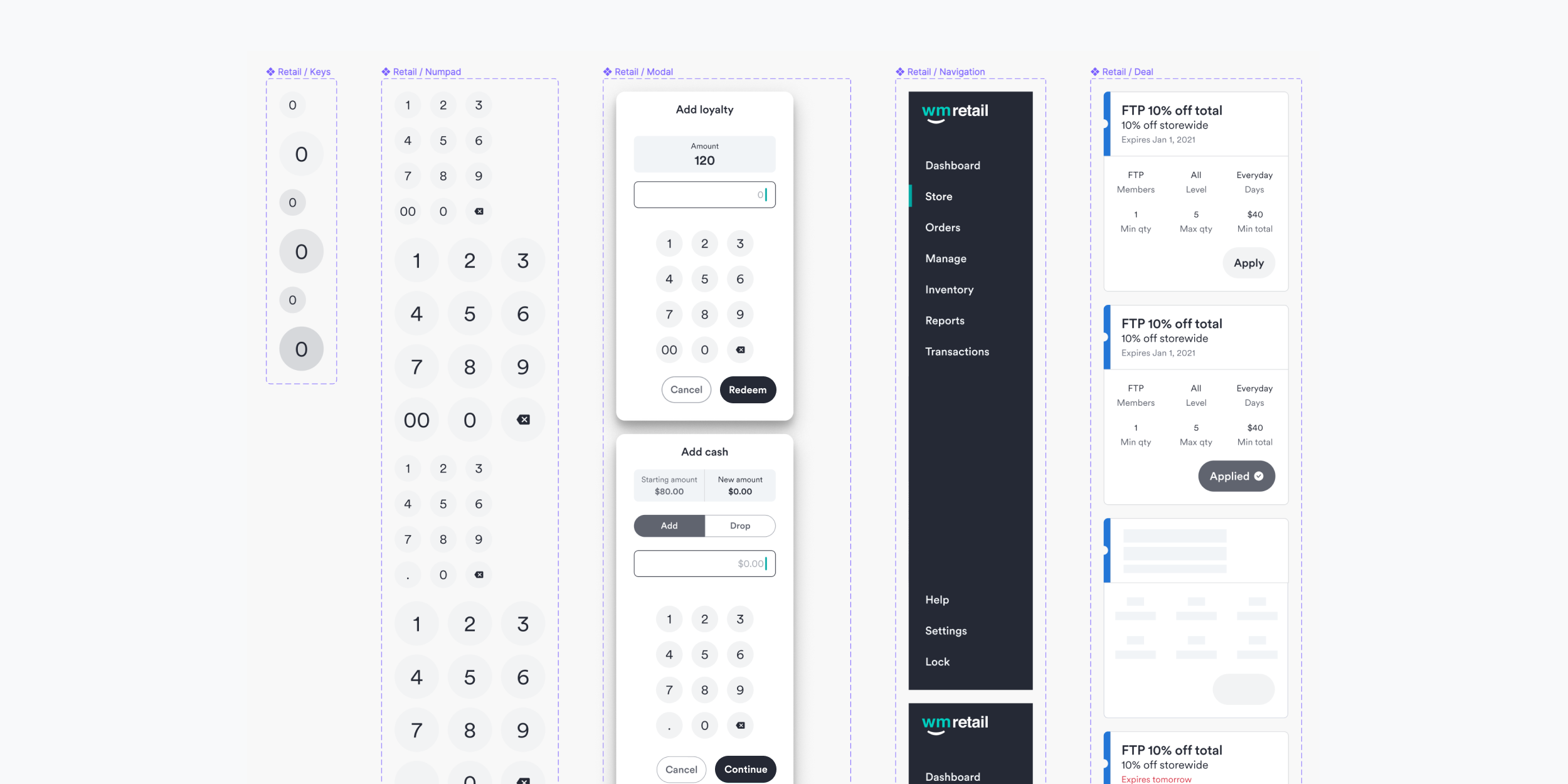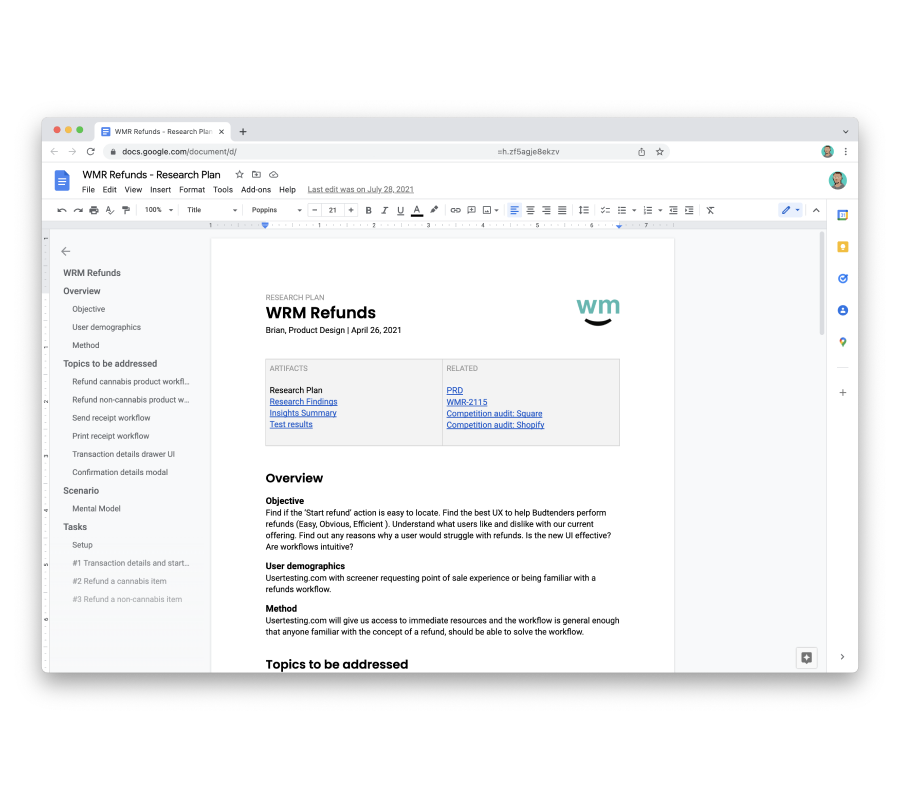WM Retail · Point of Sale Kiosk
Weedmaps · Store businesses

TL;DR
Dispensary owners struggled with fragmented workflows in a regulated industry: clunky online order management, confusing checkouts prone to errors, redundant inventory tracking, and inconsistent interfaces that increased cognitive load. Our challenge was to unify these into a scalable, compliant POS system while fostering collaboration with engineering and legal stakeholders to support business growth without compromising user trust or regulatory adherence.
Project Background
THE GOAL
Our objective was to design and optimize solutions that:
Enabled Seamless Online Order Fulfillment: Streamlining the process for dispensary owners to manage online orders.
Ensured Metrc Regulation Compliance: Implementing features that met state regulations for cannabis tracking and reporting.
Optimized Existing Features: Enhancing design solutions for Refunds, Store Checkout, and Purchase Orders to improve user experience and efficiency.
Standardized Interface Patterns: Establishing consistent design patterns throughout the app to improve usability and reduce cognitive load.
By achieving these goals, we aimed to deliver a cohesive and user-friendly experience for dispensary owners, driving business growth and compliance.
THE DESIGN CHALLENGE
To deliver a seamless experience, we faced the challenge of:
Collaborating with the Front-End Team to define scalable components that would support future growth and product evolution.
Designing Touch-Friendly Components that leveraged conventional kiosk interaction patterns, ensuring an intuitive experience.
SUCCESS METRICS
The success of our design solutions was measured by:
Increased POS Adoption: Expanding WM Retail's presence in newly legalized cannabis markets.
Improved Client Efficiency: Helping stores save time and streamline their operations to grow their business.
Enhanced Order Frequency and Throughput: Driving business growth by increasing order frequency and optimizing workflow efficiency.
Duration
1 year
Team
Product Manager
Senior Product Designer 👋
Senior Engineering Manager
3 Front-end Engineers
3 Back-end Engineers
Legal team
SOFTWARE
Figma, Atlassian, UserTesting, Google Docs, Stickies
Design Process
What Did We Start With?
Rooms: Persistent Check-in Hub
Receptionists relied on the Rooms section to quickly check in walk-ins. We optimized navigation so the hub stayed above the fold, reducing scroll friction and ensuring seamless access.
Purchase Orders: Streamlined Inventory & Compliance
Clients used Purchase Orders to manage incoming inventory. We integrated Metrc compliance directly into the flow, removing redundant steps and enabling faster, regulation-ready receiving—saving time and boosting operational efficiency.
Checkout: Unified & Intuitive Flow
The original Checkout displayed items across multiple rows, confusing new users. We redesigned with standardized item cards and a cohesive component library, simplifying scanning, review, and completion for a smoother, error-free experience.
WM Design System: Cohesive & Accessible Foundation
We audited existing components against the WM Style Guide and A11Y standards, identifying gaps and opportunities. This informed a unified redesign—streamlining aesthetics, accessibility, and consistency across the POS for a modern, inclusive experience.
Competitive Audit: Learning from Industry Leaders
We audited Square POS, Shopify POS, and Clover POS to benchmark features, flows, and interaction patterns. This revealed strengths, gaps, and productivity trends—guiding our differentiation while shaping WM Design System decisions for usability, consistency, and modern POS efficiency.




Design Goals
Streamlined check-in and checkout for efficiency and UX.
UI components aligned with WM Design System Style Guide.
Improved accessibility for inclusivity across users.
Seamless online order fulfillment accessible from the point of sale touch screen kiosk.
Metrc compliance integration for regulatory adherence.
Touch-friendly interactions optimized for POS environments.
Adherence to kiosk design conventions where applicable.
Wireframes: Iterating Core Flows
We started with low-fidelity wireframes in Figma to map and refine key user paths for check-in, checkout, online fulfillment, and Metrc integration. This iterative process prioritized efficiency, touch-friendly gestures, kiosk conventions, and early accessibility checks—aligning everything with the WM Design System for a strong, user-centered foundation.

Custom Components: Scalable & Accessible Building Blocks
We designed reusable components using atomic design principles, aligned with the WM Design System, A11Y standards, and touch-friendly interactions. These shared elements ensured visual consistency, accelerated development, and maintained accessibility and kiosk usability—laying a scalable foundation for the entire point of sale app.

UX Research: Validating with Real Users
Before handoff, we crafted a focused research plan—targeting key features, dispensary staff demographics, and core tasks—to test prototypes objectively. UserTesting sessions yielded clear, actionable insights that guided final refinements, ensuring the POS met real user needs while staying aligned with compliance and efficiency goals.
Final design
Our final interface integrates UX research insights, wireframe iterations, and custom components built to the WM Design System. The result is a unified, accessible, and touch-optimized kiosk experience that streamlines check-in, checkout, online fulfillment, and Metrc compliance—delivering intuitive workflows that support both user needs and business goals by promoting cohesiveness and efficiency.










